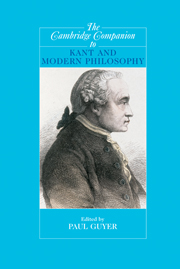Book contents
- Frontmatter
- Introduction: The starry heavens and the moral law
- 1 “A Priori”
- 2 Kant on the perception of space (and time)
- 3 Kant’s philosophy of mathematics
- 4 Kant on a priori concepts: The metaphysical deduction of the categories
- 5 Kant’s philosophy of the cognitive mind
- 6 Kant’s proofs of substance and causation
- 7 Kant and transcendental arguments
- 8 The critique of metaphysics: The structure and fate of Kant’s dialectic
- 9 Philosophy of natural science
- 10 The supreme principle of morality
- 11 Kant on freedom of the will
- 12 Mine and thine? The Kantian state
- 13 Kant on sex and marriage right
- 14 Kant’s theory of peace
- 15 Kant’s conception of virtue
- 16 Kant’s ambitions in the third Critique
- 17 Moral faith and the highest good
- 18 Kant’s critical philosophy and its reception - the first five years (1781-1786)
- Bibliography
- Index
9 - Philosophy of natural science
Published online by Cambridge University Press: 28 March 2007
- Frontmatter
- Introduction: The starry heavens and the moral law
- 1 “A Priori”
- 2 Kant on the perception of space (and time)
- 3 Kant’s philosophy of mathematics
- 4 Kant on a priori concepts: The metaphysical deduction of the categories
- 5 Kant’s philosophy of the cognitive mind
- 6 Kant’s proofs of substance and causation
- 7 Kant and transcendental arguments
- 8 The critique of metaphysics: The structure and fate of Kant’s dialectic
- 9 Philosophy of natural science
- 10 The supreme principle of morality
- 11 Kant on freedom of the will
- 12 Mine and thine? The Kantian state
- 13 Kant on sex and marriage right
- 14 Kant’s theory of peace
- 15 Kant’s conception of virtue
- 16 Kant’s ambitions in the third Critique
- 17 Moral faith and the highest good
- 18 Kant’s critical philosophy and its reception - the first five years (1781-1786)
- Bibliography
- Index
Summary
A serious and detailed engagement with the natural science of his time was a hallmark of Kant's long intellectual career. Kant's earliest “pre-critical” writings were almost wholly devoted to this subject, including such works as On the True Estimation of Living Forces (1747), his doctoral dissertation Meditations on Fire (1755), his ground-breaking formulation of the nebular hypothesis (now often known as the Kant-Laplace hypothesis) in the Universal Natural History and Theory of the Heavens (1755), and his early formulation of a so-called dynamical theory of matter in the Physical Monadology (1756). In all of these works we see Kant striving, in particular, to reconcile his firm commitment to Newtonian physical theory (including such controversial doctrines as action at a distance) with the Leibnizean metaphysical tradition that was dominant in mid-eighteenth-century Germany. And these concerns with contemporary natural science and its metaphysical foundations are by no means absent in the “critical” period, which begins with the publication of the first edition of the Critique of Pure Reason in 1781. On the contrary, Kant's most developed philosophical exploration of the foundations of natural science, the Metaphysical Foundations of Natural Science (1786), appears at the height of this period.
- Type
- Chapter
- Information
- The Cambridge Companion to Kant and Modern Philosophy , pp. 303 - 341Publisher: Cambridge University PressPrint publication year: 2006
- 3
- Cited by

